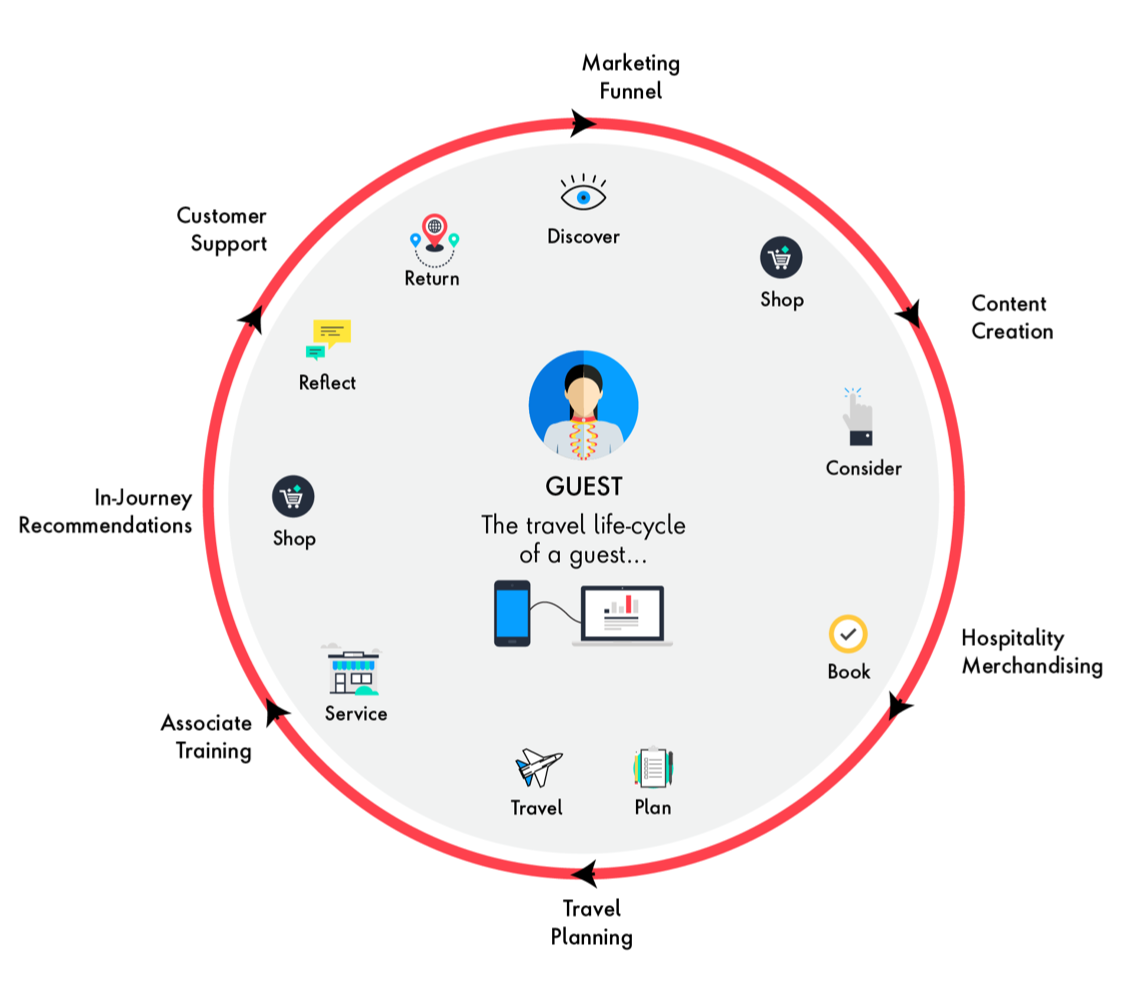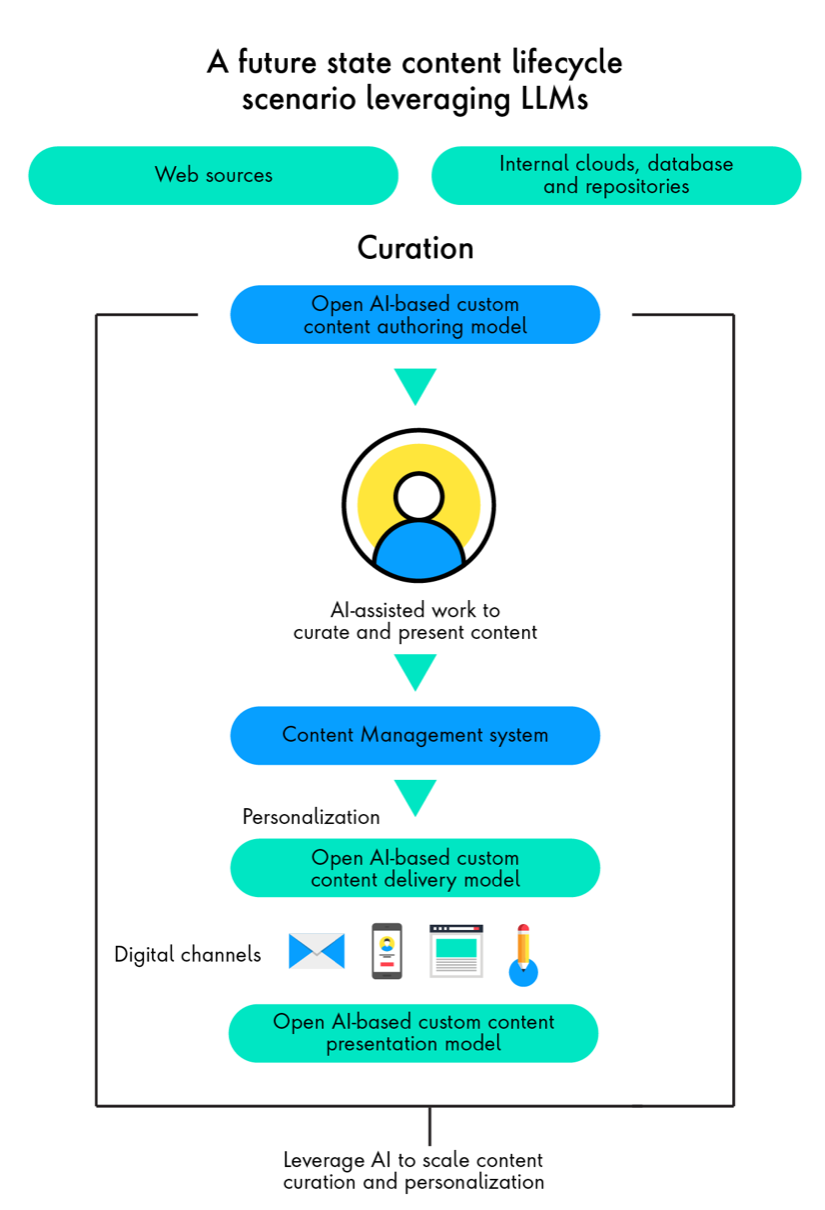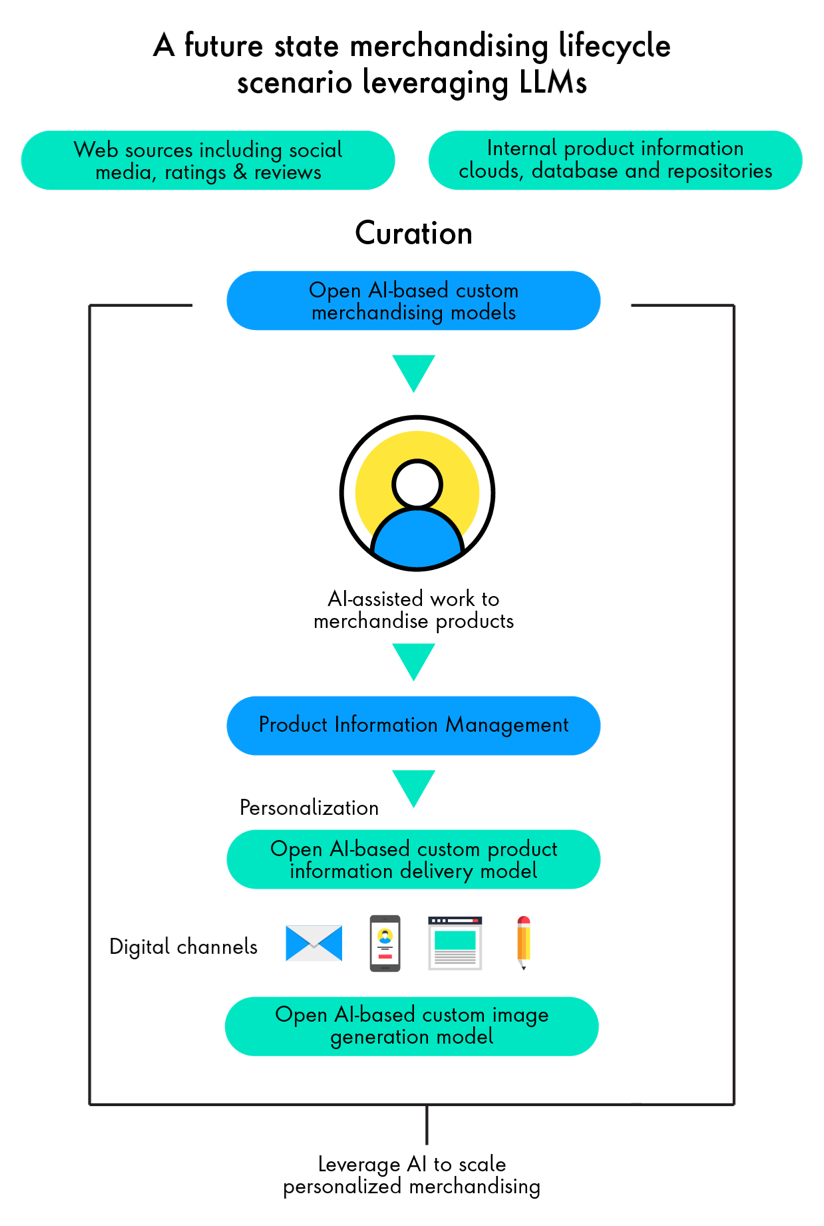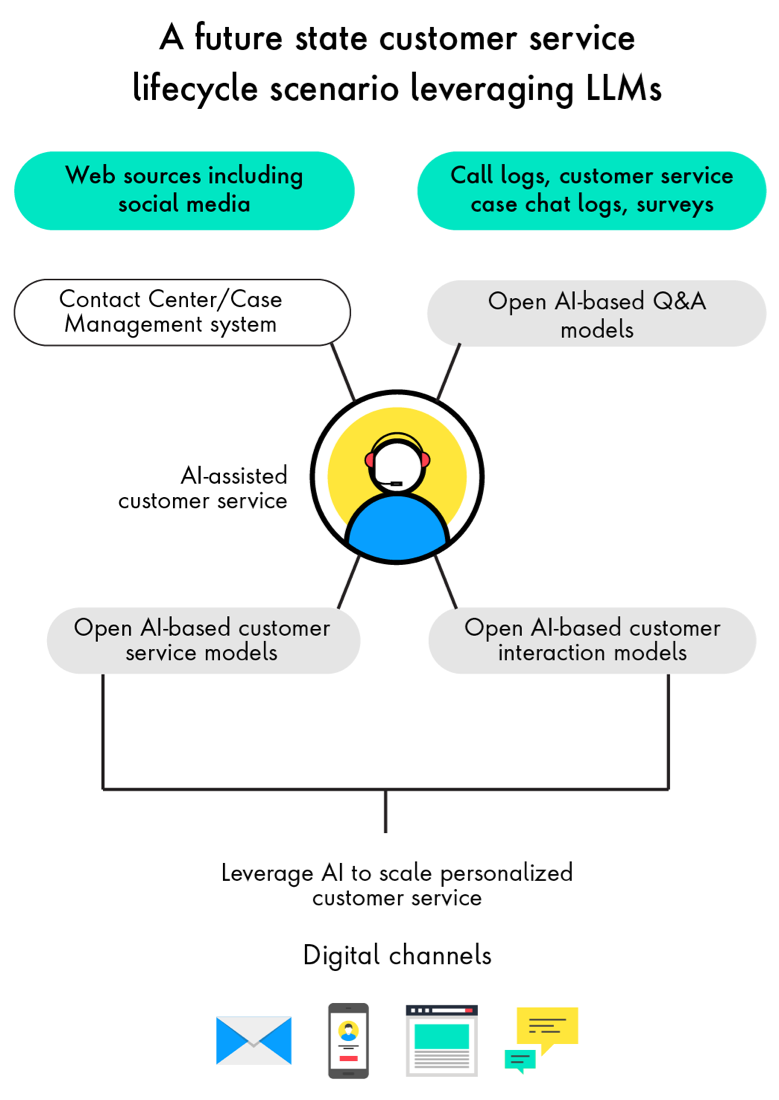What issue can we solve for you?
Type in your prompt above or try one of these suggestions
Suggested Prompt



Insights
How Can Generative AI Improve the Guest Experience?
How Can Generative AI Improve the Guest Experience?
Our experts break down the top guest experience use cases for artificial intelligence tools like OpenAI’s ChatGPT, the large language model interface that can generate code, video and conversations.
From schedule and room inventory optimization to revenue management and look-alike audience models, artificial intelligence (AI) models have already been driving revenue for travel brands for years. But generative AI enables dynamic content through faster content generation and dynamic presentation.
New generative AI tools built on large language models (LLMs) like ChatGPT and Google’s Bard have prompted industry-specific investment and applications. At the same time, rapid adoption has introduced new risks for businesses around copyright, customer trust and factual errors.
Default outputs require prompt engineering, customization and fine-tuning.
As futuristic possibilities for chat-based AI tools in travel and hospitality take shape, ambitious brands should begin testing and developing a go-to-market strategy, factoring in their unique risk tolerance and business goals.
"It’s clear that LLMs have the potential to transform digital experiences for guests and employees much faster than we previously thought,” says Head of Customer Experience for Travel and Hospitality at Publicis Sapient, J F Grossen. “However, this isn’t a sprint to the finish line to apply the latest trending technology. It should be considered in the context of a larger toolkit of products and services designed for customer needs.”
This article will explore the most realistic use cases for generative AI tools and large language models in the travel and hospitality space, how these use cases can improve the guest experience and several strategic approaches to integration for both short-term applications and long-term revenue growth through AI.
Publicis Sapient can set up AI incubators in partnership with clients, powered by our unique SPEED formula. This approach combines strategic growth and business value, modern digital product thinking, next-generation customer experience, engineering, data and AI, all while leveraging our premier partnerships with Amazon Web Services (AWS), Microsoft, Google and OpenAI.
Start a conversation
What does the travel and hospitality industry need to know about generative AI and large language models?
Large language artificial intelligence models, like GPT-4, can predict what text should come next based on unique text inputs and prompts, drawing from a large text-based data set. LLMs are just one branch of artificial intelligence, a broad term used to describe computers’ ability to mimic human intelligence through processing, synthesizing and generating information. Generative AI refers to artificial intelligence models, including LLMs like GPT-4, that can generate new content, like audio, video and text.
“What’s particularly significant about GPT-4 is that it can handle an astounding range of language processing tasks—like creating high quality and coherent summaries, formulating answers based on questions asked, and even generating code based on natural language descriptions of what a computer program should do,” says Head of Engineering for Travel and Hospitality at Publicis Sapient, Ravi Evani.
This includes sentiment analysis (“Was the traveler’s flight experience good or bad?”), text summarization (“What are the hotel guests' top requests and complaints?”) and speech recognition (“I want an egg sandwich and a small coffee, no cream or sugar”).
Why are large language models significant for travel and hospitality leaders?
GPT-4 and other advanced large language models like it have three unique characteristics that have garnered attention from the travel and hospitality industry.
These new large language models are:
-
Generative:
New LLMs are “generative” artificial intelligence, which means they do not just recognize and understand content in a domain, but rather generate new content in a much more intuitive format than ever before.
Pre-trained:
Pre-trained models are powerful because they become “few-shot” learners, generating meaningful outputs based on just a few examples instead of hundreds or thousands.
Available “as-a-service":
In the past, training or fine-tuning machine learning (ML) models required deep programming and statistics knowledge. This open access enables a low bar of entry, and brands can leverage that to play with a variety of use cases.
“This generative, conversational ability could add a layer of seamlessness and efficiency to online experiences to propel guests and employees to their end goal faster, which ultimately develops more loyalty and more revenue for brands able to work around the technology’s current limitations,” says Grossen.
What high-value use cases exist for ChatGPT across the travel life cycle of a guest?
How to improve the travel guest experience with large language models
For brands looking to invest in large language models or generative AI, there are three major use cases to enhance the guest experience: content generation, travel merchandising and customer service.
Using large language models for travel content generation
Hospitality brands can generate human-like authored content by blending hotel information (amenities, surroundings, location, reviews, etc.) with a prospective guest’s information (interests, preferences, household info, etc.) to create dynamic, personalized narratives; and, as a result, increase the propensity of a prospect to book a particular property.
-
Content Authoring:
Brands can use chat-based AI tools as writing partners, going back and forth to progressively exchange information and generate a narrative mapping to several audience personas across multiple contexts.
Content Presentation:
GPT-4's code generation ability can be leveraged to dynamically alter the presentation format based on device, viewport and other attributes without requiring frequent manual coding and human intervention.
Content Delivery:
Key content elements can be dynamically produced by large language models based on just-in-time parameters (such as booking dates, length of stay, etc.) at the point of content delivery across multiple digital channels.
The outcomes that enterprises can aim to achieve with these capabilities are increased content relevance to the audience, increased speed to market, increased efficiency and reduced cost of content production and distribution.
Using large language models for travel merchandising
LLMs can also allow brands to drastically expand website merchandising to focus on not just the core product but the entire guest experience by quickly generating probable text outputs and images by synthesizing trends and preferences from large data sets.
-
Travel bundle curation:
Brands can curate different combinations of rooms, physical goods and services based on customer reviews across social media at a highly granular level.
Travel imagery personalization:
When customers browse travel sites, each travel experience image requires photographers, graphic designers, models and creative staff for the shoot. Generative AI would enable travel brands to generate personalized images for each customer based simply on text descriptions and historical image data.
Demand trend identification:
New artificial intelligence can help travel merchandisers identify trends using social media, ratings and reviews and other subjective indicators, leveraging these to adjust the promotions for customer segments or individuals.
The outcomes that enterprises can aim to achieve with these capabilities are increased product relevance to target the audience, increased speed to market, increased efficiency and reduced cost of merchandising.
Using large language models for hospitality customer service
Finally, large language models can power knowledge sharing and customer service to support employees and guests at the same time.
“Historically, natural language processing artificial intelligence models that relied heavily on intent recognition had to be trained with canned fallback answers, producing results such as ‘I’m sorry I don’t have that information’ that increased user frustration,” says Evani. “The ability of generative AI to produce engaging, open-ended and conversational alternatives quickly can help make a difficult customer interaction more human.”
Large language models can be leveraged by travel and hospitality brands across the customer service lifecycle:
-
Customer Feedback Curation:
Large language models can help to curate customer feedback from call logs, customer service cases, chat logs, surveys, etc. and create a coherent narrative of insights and sentiments to help operations staff quickly understand how they could help better serve their customers.
Case Management Consolidation:
AI tools could help brands provide their customer service agents with quickly digestible summaries of past customer interaction history to help agents get up-to-speed on a customer’s case, thereby reducing average call handling time.
Q&A Personalization:
Brands could overlay generic answers to customer queries with contextual customer information to produce situationally aware and conversational answers to customer queries.
With these capabilities, enterprises can aim to achieve reduced handling time in customer service interactions and increased responsiveness to customer problems.
How travel and hospitality brands can get started with pre-trained large language models
While generative AI’s text and image completion features have gone viral, enterprise-grade AI tools need to be more focused, predictable and repeatable.
"Enterprises must plan to bolster relevance, accuracy and consistency of large language model outputs with internal systems, models and pipelines to create reliable solutions,” says Evani.
While AI tools are getting easier to use, enterprises must not underestimate the capabilities, including people and processes, needed to implement and leverage pre-trained models like GPT-4. The good news for digitally mature travel and hospitality enterprises is that much of the core supporting capabilities such as an AI platform or ML Ops are usually in place to some extent.
Enterprise capabilities needed to support LLMs
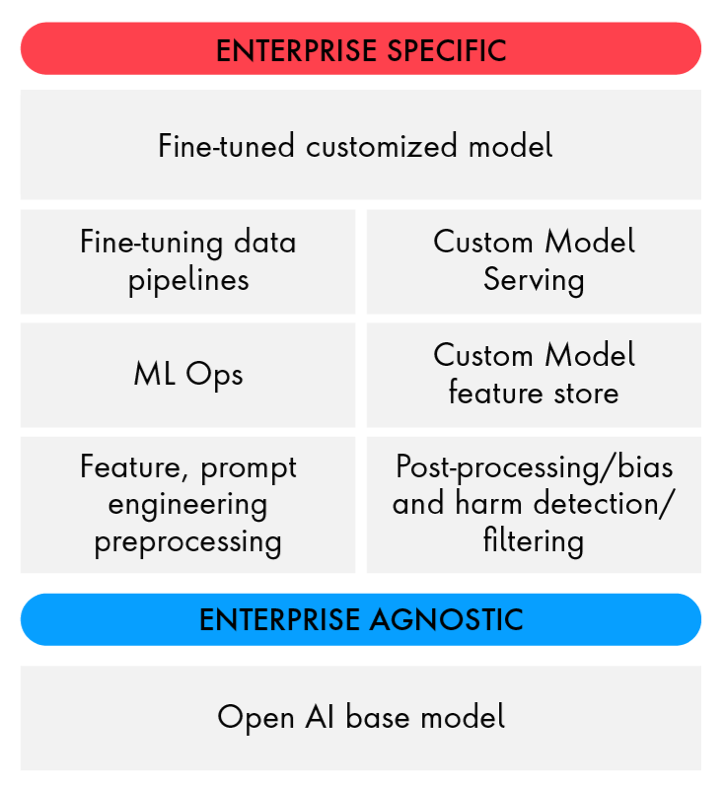
Brands will especially need to fine-tune models to enable fact-checking, reduce bias and provide transparency before production deployment.
“Travel companies currently rely on their associates to fact-check information, and new technology hasn't changed that,” says Grossen. “It just provides them with more conversational support, which in turn will create more seamless, efficient and personalized interactions.”
Three go-to-market LLM artificial intelligence strategies for the travel and hospitality industry
Large language models present an exciting yet complex opportunity to transform travel experiences, but they remain less effective without the right supporting capabilities and training.
“Brands need to narrow their focus to specific areas of expertise and train new models deeply to provide value to their employees and guests,” says Evani, artificial intelligence expert.
Innovative travel companies can get started with large language models in three different ways, starting from smaller test-and-learn investments all the way to building market-level B2B AI tools.
-
Form an internal generative AI incubator to test-and-learn:
This would allow your brand to experiment with large language models to increase the relevance, predictability and reliability of their results while tackling bias and harm with new use cases.
Design an external, branded LLM plug-in:
This would allow your brand to increase industry market share by building on and fine-tuning an advanced, open-sourced large language model.
Create a proprietary LLM or LLM-based tool for travel industry brands:
This would allow your brand to achieve long-term differentiation, providing a market-level service or even an entirely new large language model to other industry players waiting to invest.
While ChatGPT opened up new opportunities to drive value, generative AI is still just one piece of the guest experience puzzle.
“AI tools should not be designed and developed in a vacuum,” says Grossen. “Travel brands that integrate LLMs successfully will begin with a deep, empathetic understanding of their employees’ and guests’ needs and use them as a guiding compass to test-and-learn with this new technology.”





